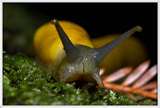|
|
Interesting, but little known Facts about Pet Slugs
1. Slugs are not insects, they are Mollusks as are clams,
snails, squid, cuttlefish and octopus, and slugs can be
found all over the world on land and even in the ocean.
2. Slugs actually do have shells, although they are small
and are underneath the skin on their back. On some slugs
such as the Leopard Slug, there is a "keel" on the back
which is a small hump where the shell is attached.
3. Slugs can follow their own slime trails that they left
the night before. Slugs can even use the slime trails that
other slugs left from the night before. Sometimes they even
create whole networks of trails to different plants or
detrius that they are eating.
4. Slugs are hermaphrodites which means that they have both
male and female reproductive organs, and yes they can mate
with themselves. When slugs mate with each other both slugs
later lay eggs.
5. A slug can stretch twenty times its own length to get
into small cracks and crevices.
6. Slugs slime is very viscous and they can use it to create
suction so that they can literally climb walls and hang from
ceilings.
7. When a slug lays eggs the eggs can stay in the ground for
years and not hatch until the conditions are correct for the
baby slugs to live. You can often find slug eggs mixed in
with garden soil because of this.
8. Slugs hibernate during the winter months using as fuel to
keep them alive the fat they have stored from the spring,
summer and fall months.
9. In the Northwestern United States there is a slug that is
a bright yellow, called a Banana Slug. It actually looks
like a banana! Some Banana Slugs can grow up to eighteen
inches long!
10. Slugs are nocturnal and will eat and wander around
during the night and sleep during the day. This keeps them
safer from their predators the birds and lizards, although
they still are not safe from frogs, toads, skunks and
armadillos, who also hunt at night. It is rare to see them
moving around during the day. They will do the most damage
to gardens and flowerbeds during the night.
11. Slugs skin is a permeable membrane that is very
susceptible to changes in their general environment. This
permeable membrane allows them to drink water from all over
their body, but it requires that they live in a humid
environment. Because of their permeable skin, if you dump
salt on a slug it will literally melt because of the osmotic
process through their skin. The water in the slugs cells
will rapidly leave the slug, dehydrating it in order to
balance out the salt on its skin and make it benign. Slugs
are killed easily by this process. But if you use this
method to get rid of unwanted slugs, choose carefully where
you sprinkle salt because once it gets into the soil nothing
will ever grow there again.
12. A slug's slime and it's tough foot let it crawl over
sharp edges and climb up plants even in the rain or when
they are waving in the wind.

Interesting facts about Sea Slugs
1. The Sea Slug is a Mollusk belonging to the class
Gastropoda, in the largest class of mollusks (phylum
Mollusca), which has a little over 35,000 living species and
15,000 fossil forms to date.
2. The Sea Slug or Marine Slug has no shell at all, unlike
its land dwelling cousins the land slugs and snails.
3. Sea Slug adults are very brightly colored and beautiful
to behold. You can find a Sea Slug species in any color of
the rainbow you might like, and many change colors according
to the food they eat.
4. The largest number and kinds of marine slugs can be found
in tropical waters like around the Caribbean Islands.
However they are also found in nearly all the oceans and
seas of the world.
5. Unlike the sea snails, salt water slugs do not have to
cling to rocks or vegetation. They can often be found
crawling along the bottom of the ocean just below the low
tide line or clinging to and eating undersea vegetation. A
few salt water slugs actually swim along the surface of the
ocean.
6. The Sea Cucumber, often called Sea Slug as well, and
popular in Chinese cuisine, is actually a very different
animal.
7. Sea slugs have been found up to a meter long (3.28 feet).
Most are under an inch long (two to three centimeters), and
some are so small that they can crawl between grains of
sand.
8. Marine slugs are regarded by many to be some of the most
beautiful creatures found in and among reefs. They often are
brightly colored with varied patterns and contrasting
colors.
9. Some salt water slugs have bright contrastingly colored
feathery structures call ceratia on their back and sides,
but not all sea slugs have these appendages.
10. Most marine slugs have two pairs of tentacles on their
heads much like their cousins the snails. The tentacles are
used for touch and smell, and there is a small eye at the
base of each of the tentacles.
11. Sea slugs eat small stationary animals that attach
themselves to reefs, rocks or plants. Sponges, bryozoans and
coelenterates are examples of some of the sea snail's
snacks. Some sea slugs feed on sea anemones and on corals.
They eat the poisonous stinging cells which then go thorough
the slug's digestive tract to the fronds on their backs and
sides (ceratia), turning their prey's defenses into the
slug's own defense.
More free info about
Slugs & Invertebrates
|